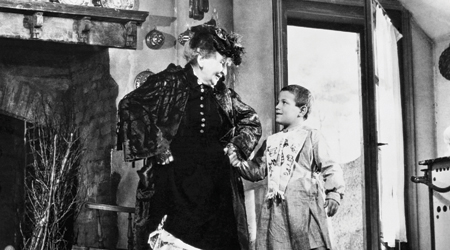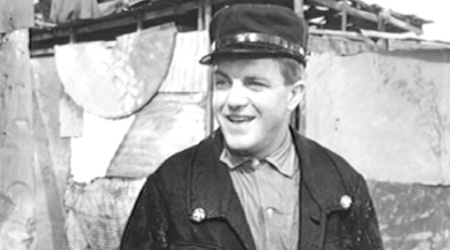BY ROB FELD
 UNFORGETTABLE: Milos Forman (above)
UNFORGETTABLE: Milos Forman (above)loved the idea that an orphan
found in a cabbage patch
by and old woman could grow up
to save his community.
The living room of the converted Connecticut barn is already hazy with smoke from limited edition Demonio Milos Forman Gold Torpedo cigars, when the namesake and current smoker of said cigars takes his seat to screen Vittorio De Sica's unique classic, Miracle in Milan (1951). Beyond the drifting smoke, credits roll over the black-and-white image of a painting of peasants at work over carnival-like organ music.
"In Czechoslovakia before the war, I'd only seen two films, says Forman in his heavily accented English. I was six years old and nobody would give me money to see Nazi propaganda films during the war. Miracle in Milan was the first I saw when the war was over. I was 19, and shocked by how moved I was by it. I saw it maybe 20 times, sometimes staying for two or three showings."
The comic and fanciful Miracle in Milan is doubly exceptional and surprising considering De Sica directed it in between Bicycle Thieves (1948) and Umberto D. (1952). Hardly associated with flights of whimsy, the master of Italian neorealism herein tells the story of Toto, an infant found in a cabbage patch by an old but vibrant spinster. She dies when Toto is a young boy, and he spends his remaining formative years in an orphanage. When he emerges a penniless young man, he is still the transcendently enthusiastic and nonjudgmental creature his adopted mother had influenced him to be. Toto then joins the local homeless, building a community of shacks on vacant land, which soon comes under threat from an industrialist, Mr. Mobbi. Sometimes slapstick farce, but always human and touching, on its surface it is far from the harsh realism of Bicycle Thieves.

"The music starts with such a feeling of happiness," Forman points out, propped at the edge of his leather chair. "It's gay. Only later do you realize its a very melancholic film. And, you see, it starts like a fairytale, he indicates as the organ theme and credits give way to strings and plucky winds, and a bucolic house by the river with the supertitle, Once upon a time. It is some kind of Italian fairytale; if a good woman cant have a child, she finds it in a cabbage patch. That was the first strangeness that triggered my interest."
We get our first good look at the old woman as she waters her cabbage and whistles to a bird. She hears crying and hurries towards its source, and a tracking camera. When her path crosses with the cameras, she bends down to rummage the leaves.
"How De Sica moves the camera, chooses lenses and angles, is so natural that it never disturbs me from following the story, and watching the characters develop. You never think about how the movie is made or how he is carefully manipulating you," says Forman.
Thirty seconds and a crossfade later, De Sica pans up to the pudgy face of Toto. "It's so nice he doesnt give us a beautiful child," Forman says. "Its a chubby little kid. One thing that is fabulous is that today I remember faces from this 60-year-old film, even the extras, more than I remember hundreds of leading men in other movies. They are wonderfully chosen, all the characters. Its a fairytale but so realistic, and that gives it a power."
The woman is being playful and joyous with Toto, but after another 80 seconds and another crossfade, she appears small on her deathbed, peering back and forth between two unfeeling, officious men, counting her heartbeats in unison. Its a death scene but De Sica plays it like comedy, says Forman, enjoying De Sica's inventiveness.
With minimal dialogue thus far, Toto follows his mothers coffin through the streets, and is thereafter brought to an orphanage, with De Sica relying on human behavior and situations for his storytelling.
With his little look behind him, we see that Toto is seeing the world for the first time. What the film is about is so touching. I was also an orphan, so maybe that helped my emotional link with the movie. Then a simple fade out, fade in, and De Sica jumps many years, Forman explains as Toto, now a young man, emerges from the orphanage door, hailing Buongiorno! to every passerby.
"Again, I think this is genius that De Sica chooses a main hero who is a short, pudgy, not at all handsome guy. It's absolutely economical what De Sica does, Forman adds, as Toto jumps in to lend a hand to a construction team he comes upon. Here you can see the kid has a good heart. He sees people working so he helps them; all he wants to do is work."
SALT OF THE EARTH: In a scene reminiscent of Chaplin and Keaton, the homeless people wake up on a cold morning and comically chase beams of sunlight, bouncing in place and singing to keep warm.
Minutes later, Toto's satchel is lifted by a scruffy old man. Wordlessly, again, De Sica continues to allow performance to reveal his story. "Toto is almost ashamed to go and claim his own possession. This is such a nice detail. We are at the very beginning of the film and already we know this character, and love him. Do you miss the dialogue? I dont at all. And yet the film is so full of emotions."
Toto winds up sleeping in a tent with the homeless man who stole his satchel, and awakens in the cold morning to find the resident homeless population comically chasing beams of sunlight from one patch of ground to another. They cluster together, bouncing in place and singing to keep warm. This scene sparks hearty belly laughs from Forman.
"It's so funny, and a little bit like Chaplin or Keaton. And it shows you the distance between the upper class and the homeless crowd. They are thankful for the sunshine. And such faces! Thats a similarity between this film and my film Fireman's Ball (1967). I'm sure that Toto (Francesco Golisano) is an actor, but I'm sure everyone else is from the street. In Fireman's Ball, they are all from the street. The way De Sica handles all his people is so natural, so real. This is real exterior, too, not a studio."
The indefatigable Toto scurries about the growing collective, allocating homes, diffusing tensions, welcoming and inspiring all. "The art department was brilliant building this town, which looks so real, and I think its lit mostly with natural light and some reflection," says Forman, tapping out his first cigar and putting his foot on the coffee table.
De Sica's world now established, a big band swing score overtakes the cacophony of environmental sounds, marking the arrival of the wealthy Misters Mobbi and Brambi, and their caravan of lackeys in flashy cars. They're here to talk about a land deal.
The music is characterizing who's coming. "Look at them," explains Forman, as the greedy businessmen stand around in their fur collars and top hats, on a hill above the raggedy homeless they barely see. "Again, it's a little bit like from Chaplin or Keaton, and hes shooting from below to show their superiority. "
Mobbi and Brambi throw numbers back and forth between themselves, De Sica cutting quickly between them in close-up, until their negotiation devolves into rhythmic, incomprehensible barks, echoed by some of the watching homeless.
"De Sica goes into the grotesque here," exclaims Forman, edging forward again. "It fits perfectly because of the tones he established from the beginning. And here it becomes political," he says, as Toto shames Mobbi into not buying the land. Momentarily transformed, Mobbi delivers an egalitarian speech about the sameness of all men, followed soon by the community marching to its anthem about the simple virtues of their life, set to the recurring theme first heard with the credits.
"This is like operetta. It's amazing the different genres and styles De Sica is combining, and it looks so natural. Some shots are almost like a documentary film. He moves so easily between the sharpest satire into the most touching and moving moments," Forman continues as a carnival seems to spontaneously break out, and tickets are sold to watch the sunset. "And now suddenly poetic. De Sica sets it all from the very beginning, with the mother and the cabbage patch."

GOOD WILL: Forman thinks it was a stroke of genius for De Sica to choose an actor to play Toto, who is short, pudgy, and not handsome at all. "You can see the kid has a good heart."
"And then, this, such a funny idea," he says, as a member of the community pokes a finger in the ground yielding a spout of oil, which catches fire and illuminates the night. "It's magical, but it works. It's De Sicas own instincts and way of telling stories. Every shot tells you part of it, moving forward and forward."
A fallen aristocrat, who is living in a shack and thinks he's better than his neighbors, sees an opportunity and sneaks off with an oil sample to see Mr. Mobbi. "With such ease De Sica is telling you everything about human nature, with different kinds of personalities and foibles. Its very interesting in this movie, and the same is reflected in my movies, Fireman's Ball especially, that not all these people are good people. They are very real, very human; they have nasty human traits and yet you love them. It's one of the mysteries, that we are living in a world that we love and hate at the same time."
The fallen aristocrat returns haughtily with his spoils in the form of a fur lined coat and coveted top hat, followed by Mobbis minions who evict the thriving community. Toto hurries off with his compatriots to remind Mobbi of the fraternal sentiments he had expressed. As Toto leaves his world and enters the reality of Mobbis stately marble office, De Sica shifts style again to more extreme camera angles and a jazz score. Toto and his group sit on the couch, accept tea and sing Mobbi their anthem.
"This is like Mussolini-style architecture," Forman observes. "Now you're in reality, and it's all so wonderful how this mob going for justice is intimidated by the wealth and pomp. The statue by his desk and the shadow adds to it. Mobbi plays them like an instrument. It shows you how goodness is navet
While Mobbi stalls, looking out the window at the troops he is dispatching to force eviction, De Sica shoots an extreme, highly architectural angle with shadows drawn long, uncharacteristic of this film. Its expressionist but in a very realistic way.
Returning home, Toto and company find chaos as their neighbors are being violently smoked out. Then, in the most supernatural of twists, when Toto shimmies up a pole to wave the white flag, he is visited by his mothers spirit, who gives him a wish-granting white dove. With the doves magical power, Toto blows away the smoke engulfing the town, provides the inhabitants with magic umbrellas and then drains the water hoses aimed at them by Mobbis army. Officers barking orders to advance suddenly find themselves singing opera in registers high and low, and slipping on newly formed ice until the whole police force is skating like children on a frozen pond. The film never stops for a breath while all this goes on.
"This is not a small movie," says Forman. "There are a lot of extras, crowds, wide shots, but things pass into new sequences so naturally. De Sica's choice of lenses is wonderful because you are never at a loss for where you are or what with youre seeing. You always have the feeling of the whole space. He's using a 35 mm lens, maybe, and he's not changing lenses that often."
The community desperately converges around Toto and his wish-granting dove, begging for fur coats, balloons, top hats, chandeliers, radios, or even to be taller.
FLYING HIGH: The peasants grab brooms form street sweepers and, in a miracle granted by a magic dove, ride them off into the heavens. "This is an absolutely unique film from every point of view."
"This is wonderful because they just want the most materialistic things. Human nature, again," Forman muses. "It's absurd but its so true. These poor people who have nothing, they dream of these things that are totally ridiculous in the surroundings they live in. But De Sica's setups and payoffs are impeccable," he says. "The screenwriter, Cesare Zavattini, is a genius. What influenced me was that everything has to have some emotional load in it.
Mobbi's forces eventually overwhelm and cart the towns inhabitants to the cathedral piazza. Too pure for this world, they grab brooms from street sweepers and, in a final miracle granted by the dove, ride them off into the heavens.
"This is an absolutely unique film from every point of view," says Forman, stopping the film and leaning back in his chair. "You just want to be touched and sucked into the story and characters, and this film fulfills it all. The funny thing is that after only a few weeks in release the film was banned in Czechoslovakia. The Communists always loved Western films that criticized the capitalist system, but the Czech sensors suddenly realized that these homeless people were flying to the West, not the East! So they banned the film because it gave the wrong message, that salvation cant be in the West. Isn't that incredible?
Living in a communist country, I knew communist ideas were perverse and totally contradicted human happiness. But I understood the social aspects of the story and sympathized with them, anyway. And, as a kid, for me what was most important was how emotionally a movie could touch me. It made me start thinking, I wish I could have this power to make an audience feel so emotionally involved in a movie. I went to see it again and again, was sitting there knowing every shot to come, and yet that was what made me feel good. I saw many other films after and realized how unique De Sica's film is. With this absolutely realistic style, you can create such a powerful fairytale."